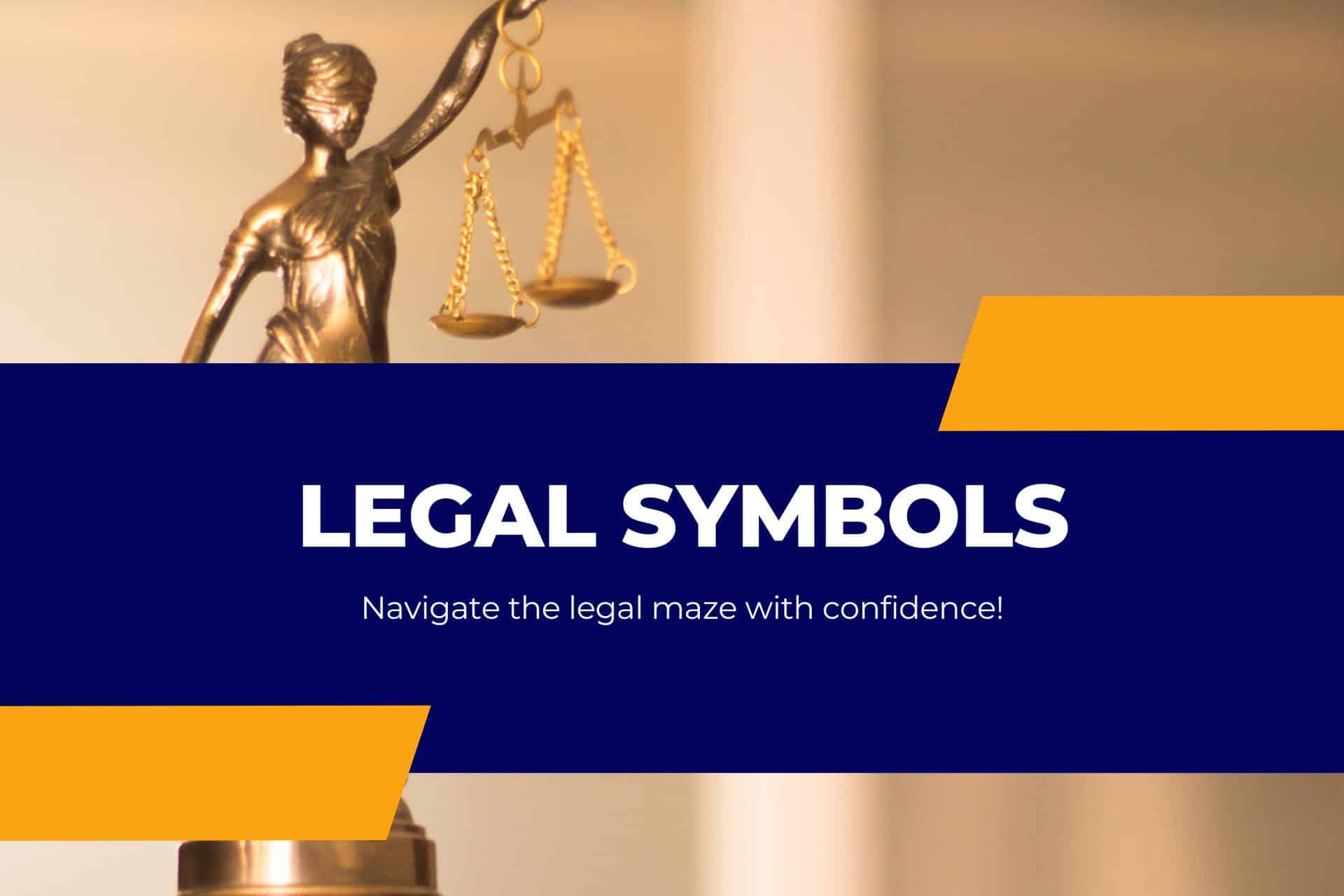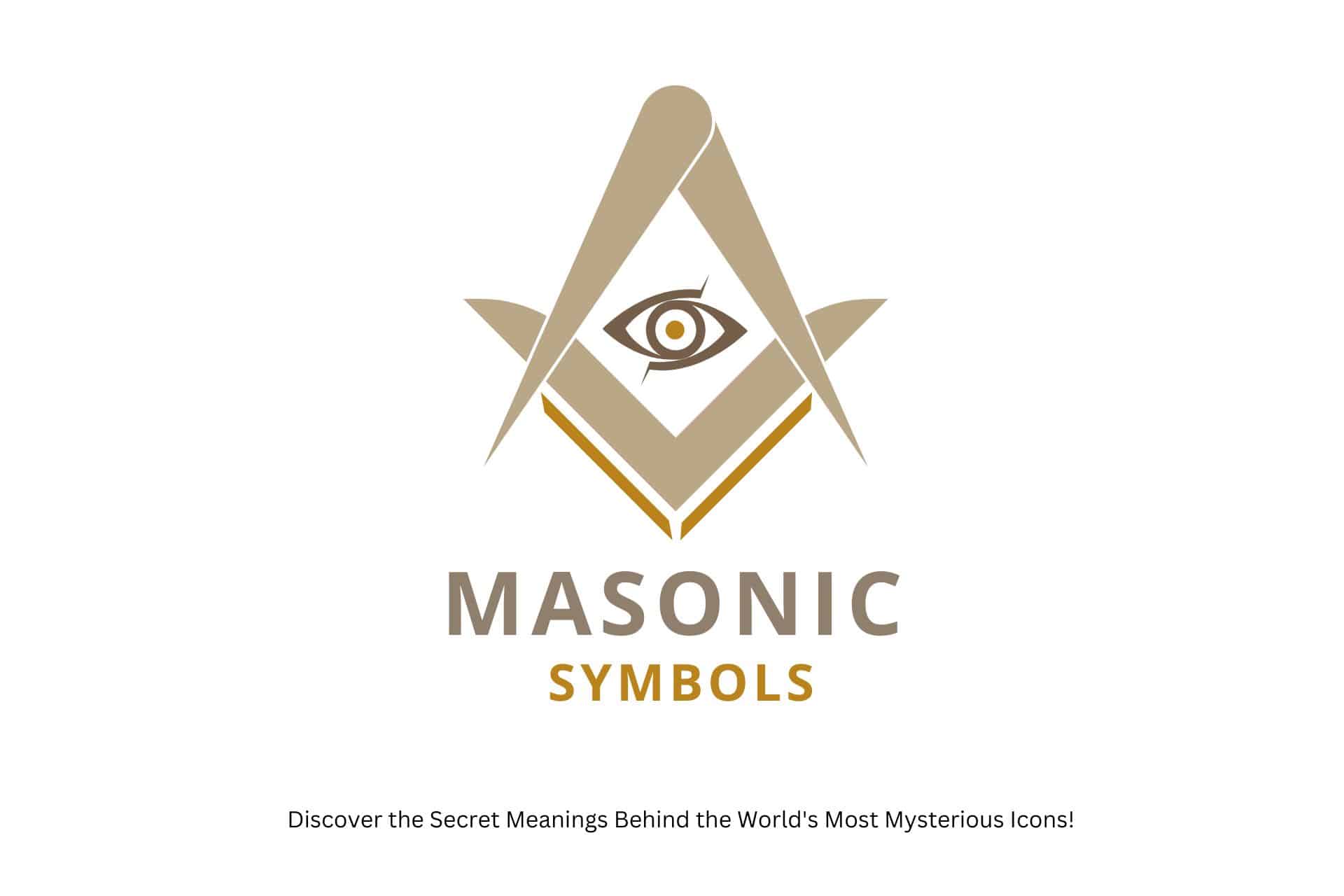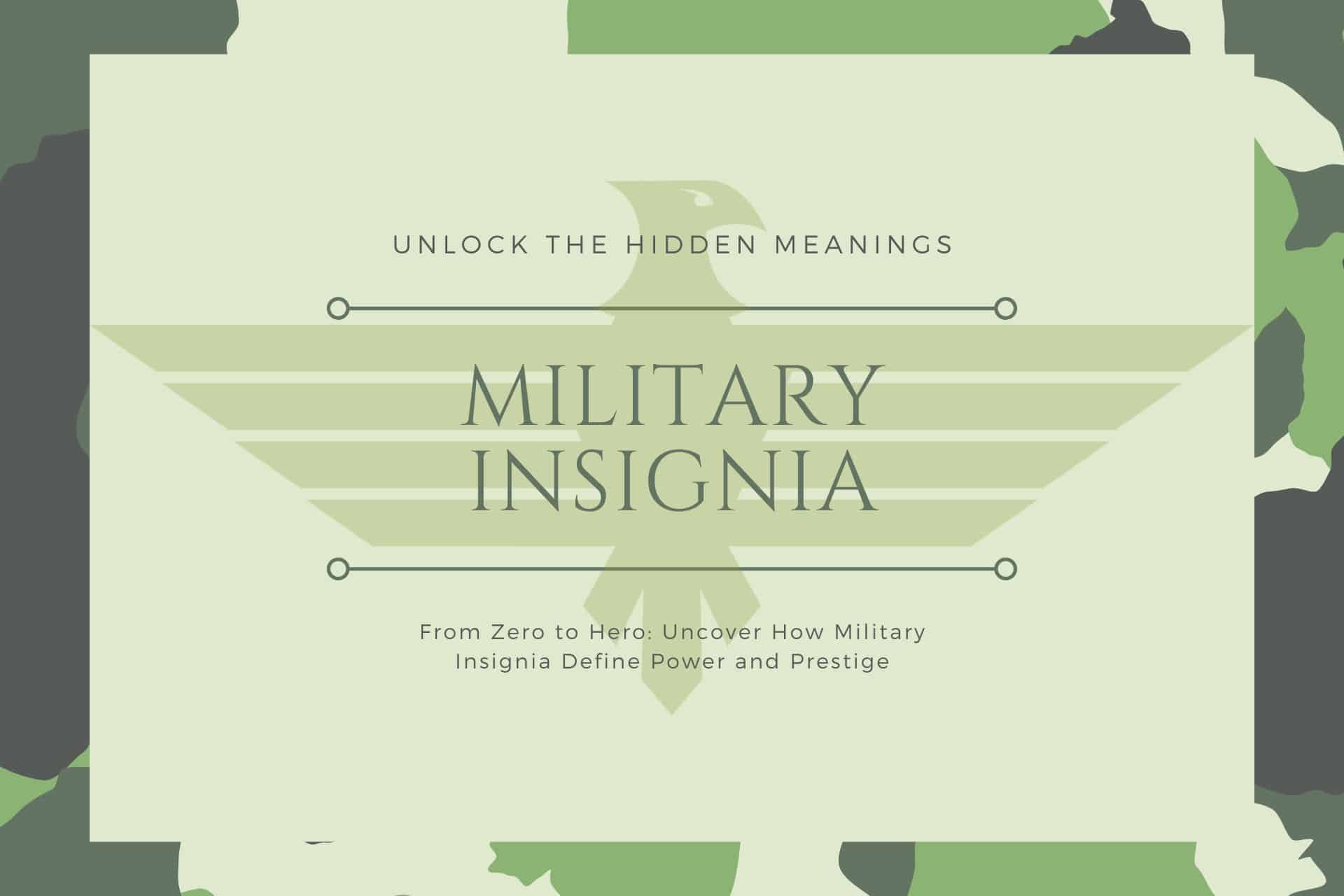Navigate the Legal Maze: Symbols That Can Make or Break Your Life!
Are you a law enthusiast or a professional puzzled by the various legal symbols? Have you ever wondered about the meanings and significance of certain symbols in legal documents?
This guide is here to remove the mystery from these symbols. It comprehensively explains their history, meaning, and cross-cultural variations. By the end of this article, you’ll be able to navigate the complex landscape of legal symbols with newfound ease and confidence.
Don’t miss out on this opportunity to enhance your legal literacy. Continue reading to demystify these fascinating elements of legal communication.
Let’s get started!

Here’s What You Will Find

Key Takeaways
Legal Symbols
Understanding Legal Symbols: Legal symbols are visual aids in legal documents that simplify complex legal concepts, aiding comprehension.
Regulation of Legal Symbols: Institutions such as the American Bar Association and the United Nations standardize and regulate the use of legal symbols on a global scale.
Importance of Legal Symbols: Proper understanding and application of legal symbols can improve legal literacy and communication and ensure consistency across legal documents.
Historical Significance and Global Examples: Legal symbols have a profound historical presence and represent fairness, authority, order, and reason in pursuing justice. Such symbols include the Scales of Justice in the US, Marianne in France, and symbols of unity in South Africa.
What Are Legal Symbols?
Legal symbols are icons, notations, and pictorial representations that serve as a shorthand to convey specific legal concepts, operations, and entities. They are the visual language of the law, enabling concise communication of complex legal ideas across various platforms, including legal documents, court proceedings, and legal discourse.
Usage and Functionality
Legal symbols are not merely for convenience; they serve several critical functions within the legal framework:
- Precision: They allow for precise representation of legal concepts without lengthy explanations.
- Clarity: They reduce ambiguity in legal texts by providing standard symbols recognized by legal professionals globally.
- Efficiency: They speed up reading and comprehension for those familiar with legal terminology and symbology.
- Notification: Some symbols, especially in intellectual property law, serve as a public notice of rights and protections.
Now, let’s get to the heart of the matter and discuss what legal symbols are precisely. They’re not some secret code but tools designed to simplify complex legal concepts. As road signs help you navigate your journey, legal symbols guide you through the law maze.
Legal symbols are visual representations in legal documents, court proceedings, and legal literature. They could be anything from Latin abbreviations, such as, ‘e.g.,’ (for example) or, ‘i.e.,’ (that is), to specific signs like © for copyright’ or ® for a registered trademark. Each symbol carries a particular meaning, making dense legal text easier to understand.
They are like the GPS of the legal world, giving you direction and clarity. Understanding these symbols is vital if you’re seeking freedom. They empower you to grasp the essence of a legal document without getting lost in jargon.
Understanding Legal Symbols
Let’s start by explaining legal symbols, beginning with a few commonly used ones. Legal symbols are keys to deciphering the law’s language. They’re like road signs guiding you to your legal destination. Understanding them helps you easily navigate the complex legal landscape and ensures your freedom to make informed decisions.
Consider the symbol ‘©.’ It’s not merely a quirky ‘c’ in a circle. It stands for copyright, protecting the creative works of authors, artists, and composers. Spotting this symbol warns against unauthorized use, safeguarding your freedom from legal troubles.
Then there’s ‘®,’ a symbol of registered trademarks. It shields brand identities, allowing businesses to thrive without fear of copycats. Recognizing it helps you avoid stepping on someone else’s brand, keeping your freedom intact.
Also, ‘±,’ often seen in patents, represents a range of values. It grants inventors the freedom to cover slight modifications without filing multiple patents. Understanding it lets you gauge the scope of a patent, maintaining your freedom to innovate.
Types of Legal Symbols
In your journey through the law’s maze, you’ll encounter many legal symbols, each with its unique role and significance. These symbols aren’t just random drawings; they’re the law’s language, conveying crucial information with precision and efficiency.
Legal symbols serve as the legal world’s shorthand. They are a collection of icons, notations, and emblems that convey complex legal concepts succinctly and universally. Legal symbols are used in various law fields, from the corporate boardroom to the courtroom, international treaties, and personal legal matters.
Here’s a look at the diverse categories of legal symbols and their roles in the intricate tapestry of law:
- Intellectual Property Symbols: These include © (copyright), ® (registered trademark), ™ (trademark), and others that protect and signify various intellectual property rights.
- Reference Symbols: Symbols like the section sign (§) and the paragraph mark (¶) refer to specific parts of legal texts.
- Procedural Symbols: Certain icons and abbreviations indicate actions or steps within legal processes, such as those used on court documents or in legal schedules.
- Regulatory Symbols: These symbols indicate adherence to legal regulations, such as environmental compliance marks or health and safety signs.
- Legal Entity Symbols: These represent specific types of legal entities, such as corporations, partnerships, or government agencies, often depicted through logos or specific letter designations.
- Court and Judiciary Symbols: Emblems or symbols that stand for different courts, such as the Supreme Court’s scales of justice or the emblems for federal or local courts, signifying the judiciary’s authority and jurisdiction.
- Statutory and Regulatory Symbols: Icons or notations in legal texts marking statutes, regulations, and legislative acts, such as the section sign (§) to reference specific provisions in-laws.
- Case Law and Precedent Symbols: Notations for citing legal cases, including abbreviations for law reports and identifiers like case numbers, aiding in legal research and referencing.
- Intellectual Property Symbols: Marks like © for copyright, ® for registered trademarks, ™ for unregistered trademarks, and ℗ for sound recording copyrights that protect creative works and inventions.
- Legal Procedure Symbols: Symbols denoting legal procedures or stages in processes, like arrows for legal actions taken or specific court form identifiers for filing or service of process.
- Contract Law Symbols: Icons that signify specific contractual terms, conditions, or clauses, often seen in the fine print of contracts and official agreements.
- International Law Symbols: Emblems representing international legal bodies or treaties, such as the United Nations flag or the International Court of Justice scales, signify global legal governance and cooperation.
- Property and Real Estate Symbols: Symbols used in property law, such as icons for land ownership, zoning symbols for real estate development, or transaction symbols in property deeds.
- Criminal Law Symbols: Icons related to criminal law, including symbols for different types of crimes, badges for penal institutions, or insignias for law enforcement agencies.
- Evidence and Litigation Symbols: Notations used in the context of legal evidence and litigation processes, like numbered exhibit tags for evidentiary items or symbols denoting the status of legal discovery.
- Legal Status Symbols: These are indicators of legal statuses or conditions, such as icons for bankruptcy, symbols for legal incapacity, or signs for protected witness status.
- Family Law Symbols: These symbols encompass family law concepts, such as graphical representations of marriage, divorce, or custody matters.
- Notary and Authentication Symbols: Seals and symbols used by notaries public for authentication, indicating that a document is certified and legally recognized.
- Legal Reference and Citation Symbols: Abbreviations and symbols commonly used in legal writing to refer to statutes, legal texts, or decisions facilitate clear and consistent legal communication.
- Law Enforcement Symbols: Badges, patches, or insignia representing various law enforcement agencies, recognizable symbols of legal authority and public order.
- Legal Education and Profession Symbols: Emblems associated with legal education institutions, professional certifications, or legal societies, which often embody the prestige and heritage of the legal profession.
- Human Rights and Civil Liberties Symbols: Emblems like the scales of justice or the liberty bell represent human rights and civil liberties, symbolizing the universal pursuit of justice and freedom.
- Environmental Law Symbols: Symbols related to environmental legislation, regulations, or agencies, used to signify compliance with environmental standards and protections.
- Financial and Tax Law Symbols: Marks denoting financial law concepts, tax categories, or economic regulations are critical in legal documents pertaining to fiscal matters.
- Maritime and Admiralty Law Symbols: Including ship registration codes, flags for legal nationality, and safety symbols used on vessels to indicate compliance with maritime laws.
- Cyber Law and Digital Rights Symbols: Digital symbols indicate copyright or licensing terms of online content, and privacy icons indicate compliance with digital privacy laws like the General Data Protection Regulation (GDPR).
Each symbol plays a vital role in the legal ecosystem. They provide a universal language that transcends words, simplifies the complex, and ensures clarity in the rule of law.
Recognition and Understanding
Understanding and properly using legal symbols is part of legal literacy and is essential for lawyers, paralegals, and anyone engaged in legal writing or contract review. These symbols must be used correctly to avoid misinterpretation that could potentially lead to legal misunderstandings or disputes.
Legal symbols form an integral part of legal communication. They streamline complex legal language and are recognized universally in law. They ensure that documents and processes are standardized, efficient, and understandable to those within the legal system.
Understanding these symbols is your pass to maneuvering the legal world with confidence. Remember, they’re tools for communication, not barriers to your freedom.
Organizations Regulating Legal Symbols
Knowing that various organizations regulate their use and interpretation is crucial to traverse the maze of legal symbols. These organizations work tirelessly to guarantee that the law’s language remains standardized, accessible, and unambiguous.
To help you navigate this terrain, here are four primary organizations:
- American Bar Association (ABA): As the largest voluntary association of lawyers worldwide, the ABA sets ethical guidelines and professional standards for legal practice, including legal symbols.
- International Association of Legal Science (IALS): This global organization promotes legal science and oversees the international standardization of legal symbols.
- International Trademark Association (INTA): INTA ensures that symbols used in trademarks and intellectual property rights are regulated and protected.
- United Nations (UN): The UN sets global standards for legal symbols, especially in international law and treaties.
Understanding these organizations’ roles helps you grasp the gravity of legal symbols. They aren’t whimsical doodles but essential tools in the practice of law.
By learning about them, you assert your freedom to confidently understand and navigate the legal landscape, empowering yourself to engage more effectively with the law.
Stay tuned for our next subtopic, ‘How to Use Legal Symbols’.
How to Use Legal Symbols
Exploring the world of legal symbols, it’s essential to know how to use them correctly to communicate effectively in legal documents and proceedings. They’re not just fancy squiggles. Each symbol has a specific meaning, and misusing them could alter a document’s interpretation, leading to potential legal consequences.
Legal symbols are essential for conveying precise legal meanings and ensuring that documents and communications are understood universally within the legal community. Here is a step-by-step guide on how to use these symbols appropriately:
Step 1: Identify the Appropriate Symbol
Before using a symbol, identify which one accurately represents the legal concept or entity you need to convey. For instance, if referring to a trademark, determine whether it is registered (®) or unregistered (™).
Step 2: Understand the Jurisdiction
Legal symbols can vary by jurisdiction. Ensure you are familiar with the symbols recognized in the jurisdiction where the document will be used, or legal action may occur.
Step 3: Learn the Formatting Rules
Legal symbols have specific formatting rules. For example, the copyright symbol is typically placed before the year of publication and the owner’s name (© 2024 John Doe). Familiarize yourself with these conventions to ensure correct usage.
Step 4: Use Symbols in Legal Citations
When citing statutes or case law, use the appropriate symbols and notations, such as the section symbol (§) for sections within a statute or “v.” for versus in case names.
Step 5: Refer to Intellectual Property Correctly
Use the correct symbols to denote the IP status of the intellectual property. This will provide legal notice to others and ensure you respect intellectual property laws.
Step 6: Adhere to Professional Standards
Symbols are part of the standardized language in the legal profession. Use them where they are expected, such as in contracts or legal correspondence, to maintain professionalism and clarity.
Step 7: Proofread for Symbol Accuracy
After using legal symbols, proofread your document to check for accuracy. An incorrectly used symbol can change the meaning of a legal statement or lead to misunderstandings.
Step 8: Stay Updated on Symbol Usage
Legal symbols can evolve, with new symbols introduced and old ones discontinued. Stay informed about updates in legal symbol usage through continuing legal education and legal publications.
By following these steps, legal professionals and individuals can use legal symbols effectively and accurately, ensuring that legal documents and communications maintain their intended meaning and validity.
Mastering legal symbols isn’t just about knowing what they mean and how and when to use them. This skill enhances legal literacy, giving you freedom and confidence in navigating legal documents.
Uses of Legal Symbols
Let’s explore the specific uses of legal symbols, shedding light on how they streamline communication in law. These symbols are essential for making legal documents more understandable and efficient. They guarantee clarity and precision, cutting through the complexity of legal jargon.
Here are some of the primary uses of legal symbols:
- Simplifying complex concepts: Legal symbols distill intricate legal concepts into easily digestible forms. They’re like a secret language that only those in the law field can decipher.
- Saving time: Imagine having to write out ‘Section’ every time it’s used in a legal document. Symbols like ‘§’ do the job much faster, saving precious time.
- Ensuring consistency: Standardized symbols help maintain uniformity across multiple documents, ensuring everyone is on the same page.
- Facilitating communication: Symbols can bridge language barriers in international law, making it easier for everyone to understand the content.
Real-Life Examples of Legal Symbols in Action
Now that you’ve learned the uses of legal symbols let’s examine some real-life examples to see these symbols in action. You’ll often see the © symbol in books, films, and music, representing copyright protection. That tiny symbol sends a clear message to the world: ‘Hands off, this is my creation!’
When you scroll through a website and come across the ® symbol, the name, logo, or slogan is a registered trademark. This symbol warns others not to use this protected mark in business or face potential legal consequences.
Have you ever signed a contract and noticed a symbol like this: §? That’s the section symbol used in legal documents to refer to a specific section. It’s a handy navigation tool that makes finding the information you need easier.
Remember when you saw a parcel of land marked with a ™ symbol? That means the owner has claimed the land as a trademark but has not officially registered it.
These examples show how legal symbols are embedded in our daily lives, helping to guide us and protect our freedoms.
Why Are Legal Symbols Important?
Understanding legal symbols is vital as they serve as silent protectors of intellectual property rights, aid in deciphering legal documents, and warn against potential legal violations. These symbols don’t just complicate things; they guarantee that the law functions efficiently.
Legal symbols are critical in so many ways, including:
- They provide clarity in legal documents by distinguishing different aspects of the law.
- They act as guides to help you navigate the complex world of law.
- They signify ownership and protection of intellectual property.
- They act as warning signs to help you avoid potential legal pitfalls.
Like traffic signs on the road, you can’t afford to ignore these symbols if you value your freedom. They’re there to guide you, protect you, and ensure your rights are respected.
The History of Legal Symbols
Having appreciated the importance of legal symbols, it’s interesting to trace their origins and see how they’ve evolved. Legal symbols have been around since the dawn of civilization. Ancient societies like the Egyptians and Greeks used symbols to represent justice and law. It’s fascinating how modern legal systems have evolved and adopted these symbols.
The Scales of Justice, for instance, is a symbol that finds its roots in the Greek Goddess Themis. They symbolize fairness and law. You’ve likely seen this symbol in courthouses, representing the balance of the argument in a trial. It confirms the enduring power of these symbols that they’ve survived centuries of change.
The gavel, too, speaks volumes about its historical significance. Originating from Norse culture, the gavel signifies authority and the power to bring order and justice. Today, this symbol is prevalent in many judicial systems.
Don’t forget the importance of symbols like the Lady Justice. Dating back to the Roman Empire, she’s blindfolded, emphasizing impartiality in the legal process. Her sword represents the power of reason and justice. Ingrained in history, these symbols continue to guide us in our pursuit of freedom and justice.
Legal Symbols Around the World
Let’s take a global tour to explore how countries use unique legal symbols that resonate with their cultural heritage and historical narratives. These symbols are deeply embedded in their legal systems and represent their quest for justice and freedom.
- In the United States, the Scales of Justice symbolize impartiality and the obligation of the law to weigh the evidence presented in each case.
- France, championing liberty, features Marianne, a national symbol representing the French Republic’s triumph over monarchy.
- Japan’s legal symbol is a mythical creature called ‘Shishi,’ a lion-like beast that wards off evil spirits, embodying their cultural beliefs in their justice system.
- South Africa’s Coat of Arms, featuring a drum and elephant tusks, symbolizes unity and the rhythm of Africa.
These symbols aren’t merely artistic representations; they declare each country’s dedication to freedom and justice. They’re constant reminders of the legal ideals we aim for, regardless of our geographical boundaries.
So, as you further explore the world of legal symbols, remember that they are not just about aesthetics but also about the values they uphold.
The Future of Legal Symbols
As we venture into the future, you might wonder how legal symbols will evolve and adapt to our changing societal values and norms. You’re not alone. The evolution of these symbols continues to be a hot topic among legal scholars and practitioners alike.
In a world where freedom is cherished, it’s fascinating to envision a future where legal symbols reflect this. Imagine symbols that are more inclusive, adaptable, and progressive. Imagine a future where traditional norms don’t confine legal symbols but instead reflect the diverse society we’re endeavoring for.
But this doesn’t mean the symbols we’ve come to know will become obsolete. Instead, they’ll evolve, just like us. They’ll retain their rich history yet adapt to better serve our needs. The scales of justice may become more balanced, and the gavel may be less intimidating.
The future of legal symbols is yours to shape. As societal norms change, so too should the symbols that represent them. You have the power to contribute to this evolution, ensuring that legal symbols continue to embody the freedom and justice we all desire.
Frequently Asked Questions
What Are Some Common Misconceptions About Legal Symbols?
You might think all legal symbols have precise, universal meanings, but that’s not always true. Their interpretations vary greatly depending on cultural, historical, or country-specific contexts.
How Can I Create My Legal Symbols?
You can’t just create your legal symbols. They’re standardized symbols recognized globally. You might develop a unique symbol within your legal documents, but it won’t have universal legal significance.
Are there Any Online Courses or Resources Where I Can Learn More About Legal Symbols?
Numerous online courses and resources are available to learn about legal symbols. Websites like Coursera or Khan Academy offer free courses, and legal resource sites often have dedicated sections for understanding legal symbols.
How Are Legal Symbols Adapted Into Different Languages or Cultures?
Legal symbols adapt to different languages and cultures through localization, not direct translation. Some symbols maintain meaning, while others change based on a culture’s unique legal system and historical context.
Has the Digital Age Impacted the Evolution or Interpretation of Legal Symbols?
Yes, the digital age has dramatically impacted legal symbols, making them more accessible and understandable globally. Yet, as symbols can now be freely adapted online, variations and misinterpretations have also occurred.
Last Thoughts
Crucial symbols play a pivotal role in law and justice. They’re not just simple graphics but influential icons that carry centuries of legal tradition. Recognizing and understanding these symbols can give you a deeper insight into legal principles. As they continue to evolve, they’ll shape our understanding of law in the future.
So, watch for these symbols – they’re more important than you think.
Before You Go
We hope you found this guide valuable and enlightening. If so, we encourage you to share this article with others who may also be interested in law and justice.
By spreading the knowledge, we can collectively enhance our understanding of legal principles and their symbols. Remember, each share can make a significant difference.
Check Other Legal Symbols
- Intellectual Property Symbols
- Reference Symbols
- Procedural Symbols
- Regulatory Symbols
- Legal Entity Symbols
- Court and Judiciary Symbols
- Statutory and Regulatory Symbols
- Case Law and Precedent Symbols
- Legal Procedure Symbols
- Contract Law Symbols
- International Law Symbols
- Property and Real Estate Symbols
- Criminal Law Symbols
- Evidence and Litigation Symbols
- Legal Status Symbols
- Family Law Symbols
- Notary and Authentication Symbols
- Legal Reference and Citation Symbols
- Law Enforcement Symbols
- Legal Education and Profession Symbols
- Human Rights and Civil Liberties Symbols
- Environmental Law Symbols
- Financial and Tax Law Symbols
- Maritime and Admiralty Law Symbols
- Cyber Law and Digital Rights Symbols
More on Symbols
History of Symbols: How Ancient Marks Shape Our Modern World!
From Cave Walls to Emojis—A Journey Through Time Have you ever wondered about the history of symbols? Maybe you’ve wondered about their global variations or how they’ve shaped our world. Prepare to have your curiosity …
Check it Out!Tattoos and Their Secret Powers: How Ink Can Change Your Life!
Exploring the Art, Meaning, and Culture of Ink! Are you intrigued by tattoos? Are you curious about the stories they tell and the intricate details they contain? Look no further. You might be wondering about …
Check it Out!Masonic Symbols Unlocked: Discover the Secret Meanings Behind the World’s Most Mysterious Icons!
The Hidden Powers and Ancient Secrets You Never Knew! Are you intrigued by masonic symbols and their profound meanings? Perhaps you’ve seen the square, compasses, or the all-seeing eye and wondered about their significance? Thankfully, …
Check it Out!Military Insignia: Unlock the Hidden Meanings Behind These Powerful Symbols
From Zero to Hero: Uncover How Military Insignia Define Power and Prestige Are you curious about the meaning behind military insignia or rank emblems? Have you ever wondered about their significance or history? This comprehensive …
Check it Out!More Symbols

















